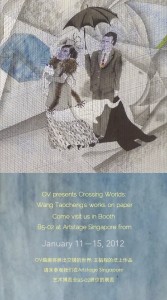Crossing Worlds : Wang Taocheng Works on Paper: Wang Taocheng’s narratives explore notions of time, identity the psyche of the artist
January 11th, 2012 - January 15th, 2012
- Show Info
- Artist Statements
- Wang Taocheng’s narratives explore notions of time, identity the psyche of the artist

The work of Wang Taocheng examines a fascinating territory between painter and painted, east and west, past and present. He employs a thoroughly post-modern sensibility (i.e. self-referential, relativistic and multi-cultural) approaching issues as diverse as tiger moms, urban decay and the sex economy.
Though he explores many social issues in his work, his paintings are also deeply autobiographical and explore his own identity issues of being Chinese and living in a Western country. We can see the artist himself peering out from densely detailed scenes dressed in different guises – standing in a subway car, lounging on the bed wearing a ghostly countenance, dressed like a hospital patient or a prince in ancient Chinese robes.
Always seeing both sides of an issue, he tears down ideologies and narratives, but at the same time reveals his own biases and leanings through his autobiographical scribblings. What emerges is a deeply personal reflection similar to a diary entry – an attempt to make sense of a vastly changing world in a style which merges Chinese painting with Western watercolor technique.
In its composition and components Wang’s work reflects the tradition of the Chinese literati painters. Like the literati, he fuses poetry with imagery, although his technique owes much more to gongbihua with its fine attention to detail. Wang adorns these images with lines from poets such as Li Bai and Cao Zhi and modern Chinese authors such as Lu Xun.
Often these lines add another layer of meaning and as is with the case of “A Romantic Person,” 2011 which depicts a working class housing project in Shanghai conveyed in a classical style with traditional imagery. In this work, Wang employs a line from the poet Cao Zhi from the poem “The Goddess of Luo River,” which tells of a man being seduced by a fair maiden calling him to come into the river. He then tosses and turns all night in a delirious erotic fever. With these lines, Wang suggests that we should not be seduced by the hulijing or “fox spirit” of nostalgia.
In another work “Abandoned Bank Garden” 2011 Wang employs the poetry of Wang Changling (Tang Dynasty, AD 618 – 907) the wistful lines of a concubine who has exiled herself to the queen’s palace to avoid a tempestuous life of court intrigue. The woman describes herself as being discarded like a paper fan of which the owner has grown tired. Here Wang makes a parallel to the grounds of the CommerzBank building in Frankfurt, which were abandoned when the Bank moved to new headquarters, leaving a somewhat empty haunted space in its wake.
At the same time, there are also Western influences in the layout of the works which look more like comic strip with panels than a traditional flowing scroll such as “Along the River During the Qingming Festival.”
In terms of medium, Wang adopts a kind of “anything goes” approach with a fair amount of watercolor technique, ink, pen and pencil drawing and a post-modern interest in appropriation, be it appropriating imagery from photographs, other artists and even and advertising slogans.
Though narrative and richly figurative, his works also attempt to disorient and jar with abstract color fields, blacked-out text and incongruous scenes and which create challenging juxtapositions. This sense of disorientation is made even stronger with the English texts in his work which he purposely makes no effort to clean up. The effect is often absurd: “Sir, Maybe you should make something that doesn’t look like itself, or not be itself. Make it ambiguously different faces so that no one could get them. Therefore can force the gate open.” It’s as if the voice of some sage or even an art professor has been run through Google Translate.
This and other texts in his work seem to be a stream of consciousness about the artist’s creative process and lingering inner doubts. It’s the kind of internal monologue and self-deferential banter typical of American comic book culture and the art of artists such as Raymond Pettibon. Wang’s work is filled with quirky, existential and somewhat circular sayings such as “I always can’t remember clearly what should be forgotten,” or perhaps a Chinese chop of a turtle that says “MOVE” in block letters.
Wang clearly has a sense of humor and is just as happy to poke fun at the might of German industry as he is at a petty old Shanghainese woman jealously guarding her crumby apartment. Wang Taocheng is one of those rare artists who’s work functions on many levels, narrative, visual, conceptual and humorous and one glance at his work doesn’t even begin to reveal the many messages and ideas hidden within its layers.
Rebecca Catching

